


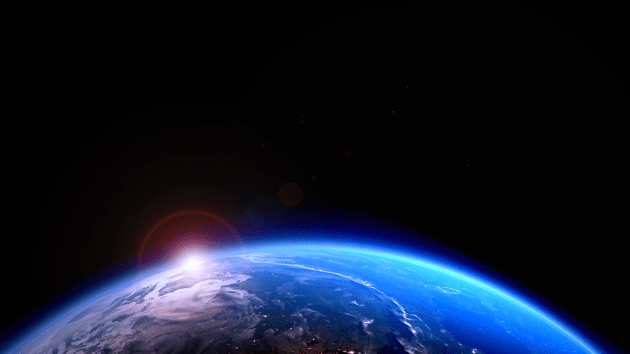
The atmosphere is the layer of gases that surrounds the Earth. It is very important because it keeps us all alive! All living animals and plants on the planet need the atmosphere to survive. The atmosphere is held to the Earth by gravity.
A mixture of gases makes up the atmosphere, including:
Water vapor is also present in the atmosphere, varying in amount depending on where you are and what time it is. For example, humid, tropical regions have more water vapor in the atmosphere (up to 4%) and cold Arctic regions have less water vapor (usually less than 1%.)

There is also some dust in the Earth’s atmosphere. This dust consists of a mixture of solid and liquid particles, including particles from pollution, volcanic eruptions, and soil that has been lifted by the wind.
The bottom of the atmosphere is heavier than the top. 98% of the mass of the atmosphere is contained in the bottom 18.5 miles. It gets gradually thinner at higher altitudes until it reaches space, where there is no atmosphere. There is no definitive boundary between the atmosphere and outer space; it just keeps getting thinner the higher up you go, until it blends with outer space. However, theKármán line is used as a boundary.
We do not notice the atmosphere because it is so spread out and formed of invisible gases, but it is actually quite heavy! Its weight is equal to a 32-ft-deep layer of water covering the whole planet.
Scientists believe that most of the gases in the Earth’s atmosphere come from early volcanoes and the oxygen came later from primitive organisms, such as bacteria, during photosynthesis- the process that plants use to make food from sunlight and other ingredients. As more complex plant life developed, more oxygen would have been added to the atmosphere, until we arrived at the 21% oxygen that makes up the atmosphere today. This amount of oxygen took millions of years to accumulate.
The atmosphere allows life to exist on Earth because:
The atmosphere acts as a giant filter, keeping out the harmful radiation from the Sun which causes sunburns and can damage living things. But it lets in solar heat (warm rays from the Sun,) which is necessary for life to survive on Earth.
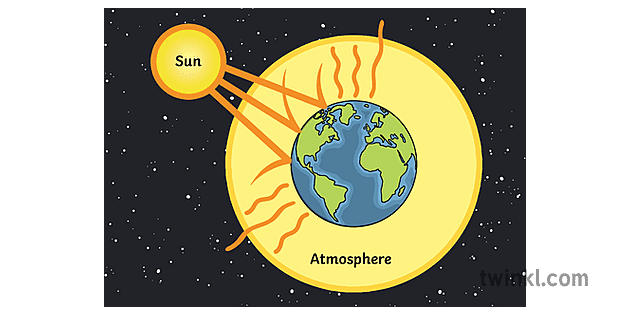
The Earth’s atmosphere is made up of layers, which extend from the ground to the sky. The boundaries between these layers are quite fluid, as they change depending on latitude and season. The layers of the atmosphere from the ground up are the troposphere, stratosphere, mesosphere, ionosphere, thermosphere, and exosphere.

All weather develops in the troposphere, which is the lowest layer of the atmosphere. This is because almost all the water vapor in the atmosphere is in the troposphere. Winds in this layer of the atmosphere move masses of air and different high-pressure and low-pressure areas, which causes weather changes and patterns. The troposphere can change in a sudden and violent way.
This layer begins at the ground and extends to about 3.7 miles at the poles and to about 10 miles at the equator. As we go further up in the troposphere, the air thins and the temperature decreases. This is why the top of a mountain is colder than the valleys below.
Heat from the Sun can penetrate the troposphere easily. Winds high up in the troposphere are very useful for planes.This is because jet streams are present in the upper part of the troposphere, which are fast-moving winds that planes can fly in to save time and money. It is quicker and more efficient to fly in a jet stream than in the thicker air below.

This calm layer of the atmosphere reaches from the troposphere to about 30 miles above the Earth’s surface. It is a very dry layer without many clouds. Any clouds in the stratosphere are thin and wispy. As you get higher up in the stratosphere, the temperature increases - the opposite of the troposphere! The planes that can fly in this layer are lucky because there are strong horizontal winds to aid the flight, but little turbulence.
We are also lucky that the stratosphere exists because it helps protect us from harmful UV radiation from the Sun, due to containing small amounts of ozone (a form of oxygen.) The part of the stratosphere with this thin layer of ozone is called the ozone layer. The amount of ozone in the Earth’s atmosphere is decreasing, which scientists believe is due to chemicals called CFCs being released into the atmosphere from aerosol sprays. The use of CFCs is banned in most countries around the world and now the ozone layer is slowly recovering.
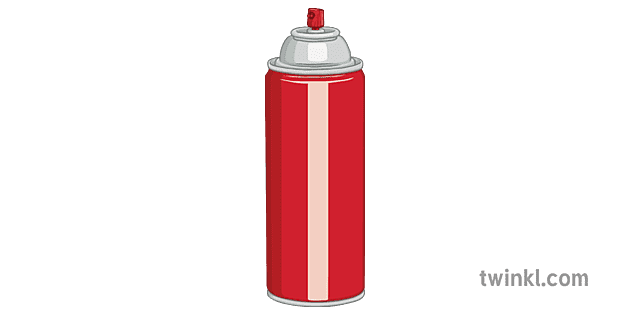
The mesosphere is the coldest layer of the atmosphere, with a minimum temperature of -184 °F. It stretches to about 52 miles above the Earth’s surface and the highest clouds in the atmosphere form here, which look like silvery wisps you can see after the Sun sets. These clouds are made of ice because the mesosphere is so cold! When we see shooting stars, we are seeing them in the mesosphere.

This is the layer that scientists know least about because it is too high up for planes or weather balloons, but too low for spacecraft. There are two phenomena that happen in the mesosphere that we don’t yet understand the causes of, which are called sprites and elves!
This layer of the atmosphere conducts electricity. This is where the Northern and Southern lights form - the colorful patterns of light in the sky that you can see from the poles. These beautiful light displays are created by charged particles in the ionosphere reflecting the solar wind, which is a stream of charged particles from the Sun.
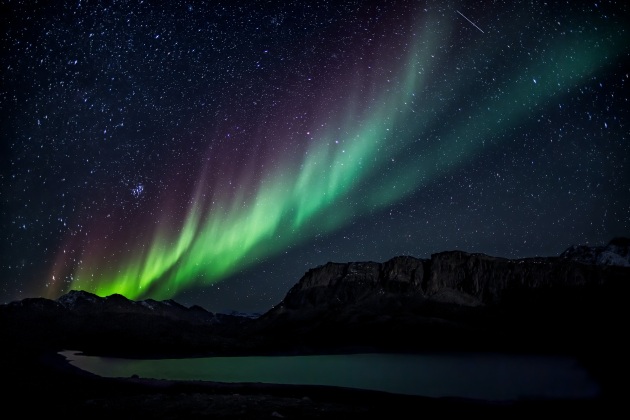
Radio waves bounce off particles in the ionosphere. This was proved by a man called Marconi, who sent a radio signal from England to Canada in 1901. Marconi proved that radio signals bounce off the ionosphere, rather than traveling in straight lines.
The thermosphere is the thickest layer in the atmosphere, extending to 430 miles above the Earth’s surface. This is where the lightest gases can be found, including oxygen, helium, and hydrogen.
This layer is home to the International Space Station (ISS) and the Hubble Space Telescope.These satellites are in what is called "low-Earth orbit." Gas molecules are very spread out in the thermosphere. Temperatures here can be very high, reaching 2700 degrees Fahrenheit, but it is not very hot in the thermosphere because there is not much pressure. Heat is caused when molecules pass energy onto each other in an area of high pressure.

This is the layer of the atmosphere that you can see in satellite images of the Earth as the fuzzy blue layer surrounding our planet. The exosphere is home to many weather satellites, which are in "low-Earth orbit" or "medium-Earth orbit."
Hydrogen is the main element in the exosphere, with only trace amounts of helium, carbon dioxide, oxygen, and other gases. The exosphere stretches and shrinks depending on what is happening with the Sun. When solar storms happen, the exosphere is squeezed to about 620 miles above the Earth. When the Sun is calm, the exosphere stretches to about 6,200 miles.
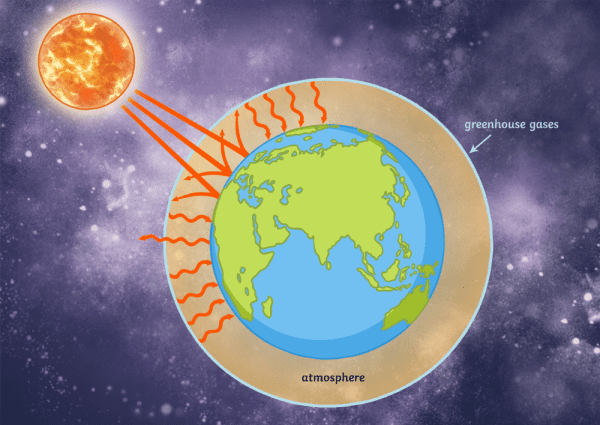
The greenhouse effect is a process that happens in the atmosphere and causes the Earth to warm up, which leads to climate change. The greenhouse effect is when greenhouse gases in the atmosphere, such as carbon dioxide and methane, trap energy from the Sun. Humans have increased the amount of greenhouse gases in the atmosphere by burning fossil fuels, like coal and oil. We need a certain amount of these gases in our atmosphere to retain heat from the Sun to warm up the Earth enough. But too much is not good news! This is because too much heat can cause the Earth to warm up too much, which is very damaging to the planet and life on Earth.
As well as studying the Earth’s atmosphere, scientists study the atmospheres of all the planets in our solar system. We know that none of these planets has an atmosphere that contains the right ingredients for life as we know it. This is because life is not possible without a stable atmosphere made of hydrogen, oxygen, nitrogen, and carbon in the right balance. Water must also be present on a planet for life to form.
Use our Layers of the Atmosphere Worksheet to help students visualize the atmospheric layers. Students will be asked to create a color key in order to label the different layers of the atmosphere. The layers of the atmosphere children will cover in this resource are troposphere, stratosphere, mesosphere, thermosphere, and exosphere.
Our Layers of the Atmosphere Labeling Activity is a great interactive resource to use when teaching children about layers of the earth. The activity includes key vocabulary related to layers of the earth.
Provide a helpful reference for your students with our Layers of the Atmosphere Poster. Print and display this poster which includes the layers of the atmosphere and their distances.